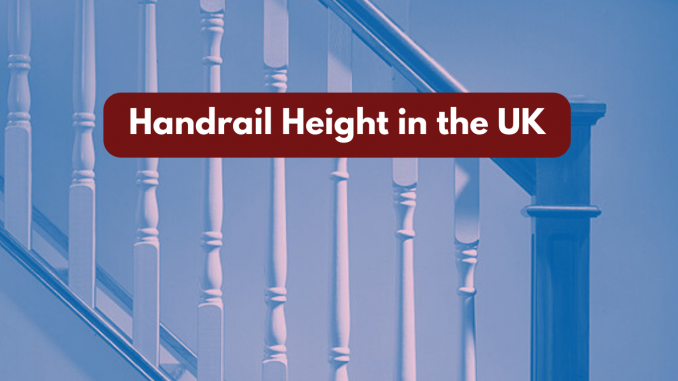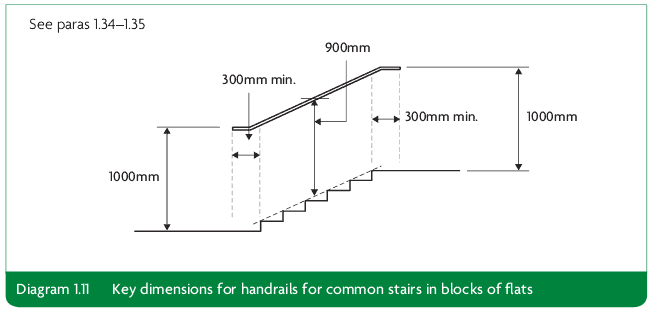
Handrails are structural elements designed to provide support and guidance to people navigating stairs, ramps, or other inclined surfaces. They are typically installed along one or both sides of a staircase or ramp and are used to help individuals maintain balance, stability, and safety while ascending or descending. Handrails are usually mounted at a height that is comfortable for users to grasp easily.
What is the Standard Handrail Height in the UK?
In the UK, the standard handrail height for stairs and ramps in public buildings is typically set between 900mm and 1000mm (90-100 centimetres or approximately 35-39 inches) above the pitch line or the surface of the ramp. This height is designed to provide adequate support and safety for individuals using the stairs or ramps. However, it’s essential to verify local building codes and regulations as requirements may vary depending on the specific jurisdiction or building type.

Handrail Height Regulations
In the UK, handrail regulations are outlined in the Building Regulations, specifically in Approved Document K: Protection from falling, collision and impact. Here are some key points regarding handrails:
- Height: Handrails should be positioned between 900mm and 1000mm above the pitch line (the line connecting the nosings of successive steps) on stairs and ramps.
- Continuity: Handrails should be continuous along the length of the stairs or ramp, except where interrupted by entrances or doorways.
- Strength and Stability: Handrails should be capable of withstanding a reasonable amount of force and should be securely fixed to the structure of the building.
- Clear Width: Handrails should have a clear width of at least 50mm from the wall or any other obstruction.
- Material and Grip: Handrails should be constructed of a material that provides an adequate grip, such as wood or metal, and should not present any sharp edges or projections.
- Extensions: Handrails should extend beyond the top and bottom of the stairs or ramp to provide continuous support for users as they ascend or descend.
- Contrast: Handrails should provide a visual contrast with their surroundings to aid users with visual impairments.
It’s important to note that these regulations may be subject to updates or amendments, so it’s essential to consult the most recent version of Approved Document K and any additional guidance provided by local building control authorities. Additionally, specific requirements may vary depending on things like bedroom sizes, ceiling heights and the type of building and its intended use.
FAQs for Handrail Height in the UK
What is the standard handrail height in the UK?
The standard handrail height in the UK is typically set between 900mm and 1000mm (90-100 centimetres or approximately 35-39 inches) above the pitch line or the surface of the ramp.
Why is there a specific height requirement for handrails?
The height requirement ensures that handrails are positioned at a level that provides adequate support and safety for individuals using stairs or ramps, allowing them to maintain balance and stability.
Are there variations in handrail height for different types of buildings or structures?
While the standard height range applies to most situations, there may be variations depending on specific building codes, regulations, or the intended use of the building. For instance, handrails in facilities catering to children or individuals with disabilities may have different height requirements.
Can handrails be installed at heights outside the standard range?
Handrails should ideally fall within the standard height range to ensure compliance with regulations and provide optimal support for users. Deviations from this range may require special consideration and approval from building authorities.
How do I measure the height of a handrail?
Handrail height is typically measured vertically from the pitch line or the surface of the ramp to the top of the handrail. It’s important to ensure accurate measurement to comply with regulations.
What are the consequences of not complying with handrail height regulations?
Non-compliance with handrail height regulations can result in safety hazards and may lead to legal issues or difficulties obtaining building permits. Ensuring compliance helps mitigate risks and promotes safety for building occupants.
Are there specific requirements for handrail extensions at the top and bottom of stairs?
Yes, handrail extensions are typically required to provide continuous support for users. They should extend beyond the top and bottom of stairs or ramps to facilitate safe movement and transitions.
These questions and answers serve to clarify common inquiries regarding handrail height regulations in the UK, helping individuals understand and adhere to relevant standards for building safety and accessibility.

Leave a Reply